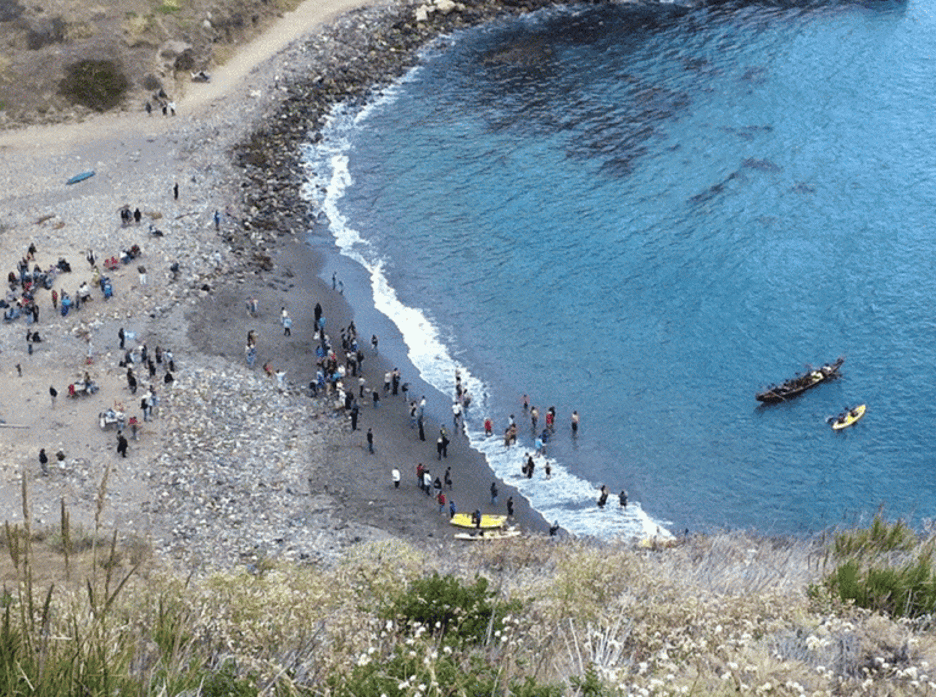
by Karen Telleen-Lawton, Noozhawk Columnist, (read the original column in Noozhawk)
By now, you’ve probably heard of the proposed Chumash Heritage National Marine Sanctuary.
Local governments, nonprofits, Native Americans, and supporters are paddling hard to win approval before the 2024 elections, to avoid the potential of having to begin anew. Some have worked towards the Marine Sanctuary designation for over 40 years.

The history of people plying the proposed sanctuary waters dates back millenia. Chumash have paddled their traditional tomols in the area for more than 13,000 years. As evidenced by their stories and middens rich with clam, mussel, and abalone shells, Chumash traditions and spirituality revolve around the water.
During the 1980s, local community members and elected leaders began advocating for protection in earnest. In 2015, two years after the Northern Chumash Tribal Council launched a campaign for formal designation, NOAA (the National Oceanic and Atmospheric Administration) accepted their application for protecting 7,000 square miles including 156 miles of coastline on the Central Coast.
After a period of limbo during the past U.S. federal administration, the designation request is back onstream. Interior Secretary Deb Haaland, the first Native American appointed to a cabinet secretary post, has spoken in favor of the proposal. Other members of the Biden Cabinet support it as well.
The Chumash Heritage Marine Sanctuary would be the first tribal-nominated national marine sanctuary designation in the U.S. As such, expectations are high that the sanctuary would not only protect biodiversity but help Chumash restore their heritage and culture.
Inclusive partnerships could lead to nature-based solutions and valuing indigenous perspectives and cultural values in ocean conservation.
NOAA will soon release documents for 60 days of public comments. Next steps include incorporating public suggestions and state and federal review. The application highlights economic wins including the creation of 600 jobs and an economic boost of $23 million.
In terms of potential biodiversity advantages, a reasonable comparison may be found in Channel Island National Marine Sanctuary (CINMS).
For CINMS, each decade report has indicated an increase in abundance and biomass of targeted fish species inside the sanctuary. Fishing boats tend to hang out just beyond the limits, benefitting from species who don’t know the sanctuary boundaries.
For the proposed CHNMS, baseline data is already being collected. Thirty sound recorders on the Pacific Ocean floor sense resident and migrating fish, whales, and even boats and underwater explosions.
Lindsey Peavey Reeves, the project’s coordinator for the National Marine Sanctuary Foundation, says, “We’re learning what the ecosystem and soundscape are now before there’s offshore wind [power] and a national marine sanctuary.”
Unanimous approval isn’t assured, even under today’s favorable conditions. Cierco Wind Energy has been planning to build wind turbines in the proposed area.
The company supports the designation of the sanctuary, but there is disagreement about energy development among stakeholders, including the Chumash. The Santa Ynez Band supports wind energy in the sanctuary, while the Northern Chumash Band opposes.
The Pacific Coast Federation of Fishermen’s Association officially “wishes the Chumash well in their endeavor.” Some are reportedly concerned that the sanctuary could harm their business, but “the effect depends on how well it is managed.”
The designation would bring increased government resources for ecological research, and public education and outreach. The Chumash would play a unique leadership role.
The proposed sanctuary “gives us a platform to grow our culture and history in a safe place,” says Violet Sage Walker, a Chumash leader. “The more people know about us, the less stereotypes and less misconceptions they have about us — the more they learn about us.”
The proposed CHNMS is the culmination of Chumash efforts in recent decades to raise awareness and rekindle Native American culture.
Tomoleros have been teaching their tomol-making craft in Santa Barbara schools in recent years. Since 2001, Chumash have completed an annual cross-channel tomol row to Limuw (Santa Cruz Island).
This year’s crossing is slated for Aug. 11-13. Perhaps, in a year or so, they’ll be paddling through the Chumash Heritage National Marine Sanctuary, custodians again of their sacred waters.

Karen Telleen-Lawton, Noozhawk Columnist
Karen Telleen-Lawton is an eco-writer, sharing information and insights about economics and ecology, finances and the environment. Having recently retired from financial planning and advising, she spends more time exploring the outdoors — and reading and writing about it. The opinions expressed are her own.

